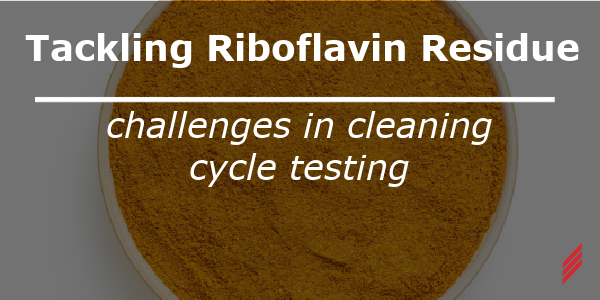Tackling Riboflavin Residue Challenges in Cleaning Cycle Testing
by Jon Edgar on Jul 31, 2025 10:30:00 AM

Solve riboflavin residue issues in pharma cleaning with tips on dilution, rinsing, and spray coverage. Improve testing reliability today!
When it comes to testing the efficacy of the cleaning cycle, riboflavin testing has been a widely used method for visualizing the effectiveness of pharmaceutical washers. Riboflavin fluoresces bright green when placed under ultraviolet light, thus producing a clear visual indication of cleaning cycle effectiveness. Operators often encounter a frustrating issue: riboflavin residue can be difficult to remove.
Why Riboflavin Can Be Challenging to Remove
Riboflavin is usually applied using a dilute solution in a sprayer or mister. If the solution dries or is overapplied, it can adhere to the surfaces it is sprayed on. This problem is especially pronounced in vial washers and other equipment that may have tight corners, around spray nozzles and rails, vial or glassware racks, and solution drains, which will make solution removal more difficult. Common causes include:
- Riboflavin concentration is too high: Using too much riboflavin increases the likelihood of residue.
- Drying on surfaces: Letting the solution dry before rinsing can create tough films.
- Incomplete rinsing: Inadequate water coverage or poorly designed spray patterns can leave residue behind.
- Water quality issues: Hard water or inconsistent pressure can reduce rinsing performance.
- Insufficient cycle time or detergent concentration.
Strategies for Better Results
Here are several practical steps to make riboflavin testing more effective and less frustrating:
- Ensure Proper Dilution
A little riboflavin goes a long way. Typically, a 0.2% to 0.5% solution will make visualization easy. Make sure to use a mist of the solution in order to prevent overapplication. While applying the solution to the surfaces, be sure to keep the solution thoroughly mixed.
- Preventing Drying
Apply riboflavin just before starting the cycle.
- Use the Correct Temperature Water for Rinsing
Slightly elevated water temperatures (86–104°F or 30–40°C) can improve solubility and make it easier to remove riboflavin films.
- Improve Spray Coverage
Use UV inspection to evaluate rinse spray patterns and identify areas that aren’t being reached. Adjust nozzle angles or add more spray heads if necessary.
- Target Contact Interfaces
Pay special attention to areas where vials or components rest against surfaces, such as rack contact points, rails, or grippers. These spots are often obscured from spray coverage and retain residue. High-resolution UV imaging or borescopes can help inspect these challenging zones.
- Rinse Thoroughly
Use a high-volume, continuous rinse with fresh water—ideally purified or WFI. Avoid recirculating rinse water during testing, as it can reintroduce riboflavin and skew results. Continuous fresh rinsing generally yields better results than intermittent bursts.
- Alternative Methods
If riboflavin remains difficult to remove, consider these alternatives or supplemental techniques:
- Fluorescein: Another fluorescent dye that may be easier to rinse off while still providing effective visual feedback.
- TOC Swabbing or Rinse Sampling: Total Organic Carbon (TOC) testing doesn’t replace riboflavin testing but complements it. While riboflavin shows where cleaning agents reach, TOC testing confirms whether organic residues are adequately removed, even in areas that aren't visible.
Conclusion
Riboflavin testing is a valuable tool for validating cleaning procedures, but like any method, it has its challenges. By optimizing dilution, rinsing strategies, and equipment setup, you can minimize residue issues and improve testing reliability. If riboflavin testing has been a pain point in your facility, revisiting your protocols may yield big improvements with just a few small changes.
About the Author
Jon Edgar is the Commissioning and Qualification Team Lead for the Apex, NC office. He provides qualification and compliance consulting services to the Life Science Industry. Jon currently guides customers through the process of qualifying facilities and equipment used in pharmaceutical manufacturing.
Read My Hallam Story
About Hallam-ICS
Hallam-ICS is an engineering and automation company that designs MEP systems for facilities and plants, engineers control and automation solutions, and ensures safety and regulatory compliance through arc flash studies, commissioning, and validation. Our offices are located in Massachusetts, Connecticut, New York, Vermont and North Carolina Texas, Florida and our projects take us world-wide.
You May Also Like
These Related Stories

3 Tips for Managing Safety with Remote Crews

This Is The Year Of Retro-Commissioning. Here’s why!


.png?width=600&height=400&name=Riboflavin%20testing%20%20(1).png)


No Comments Yet
Let us know what you think